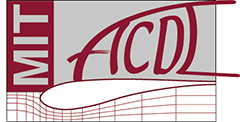27 August 2013
12:00 pm to 1:00 pm
A Discontinuous Galerkin Chimera Overset Solver
Marshall Galbraith
Postdoctoral Associate
Department of Aeronautics and Astronautics
MIT
Abstract:
The Chimera overset method has traditionally enabled the use of high-order finite difference and finite volume approaches such as WENO and compact differencing schemes, which require structured meshes, for modeling fluid flow associated with complex geometries. The large stencil associated with these high-order schemes can significantly complicate the inter-grid communication and hole cutting processes. Unlike these high-order schemes, the Discontinuous Galerkin (DG) method always retains a small stencil regardless of the order of approximation. The small stencil of the DG method simplifies the inter-grid communication scheme as well as hole cutting procedures. The DG-Chimera scheme does not require a donor interpolation method because the DG scheme represents the solution as cell local polynomials. Hence, the DG-Chimera method does not require fringe points to maintain the interior stencil across inter-grid boundaries. Thus, inter-grid communication can be established as long as the receiving boundary is enclosed by or abuts the donor mesh. This makes the inter-grid communication procedure applicable to both Chimera and zonal meshes. The small stencil implies hole cutting can be performed without regard to maintaining a minimum stencil and thereby greatly simplifies hole cutting. Hence, the DG-Chimera scheme has the potential to greatly simplify the overset grid generation process. Furthermore, the DG-Chimera scheme is capable of using curved cells to represent geometric features. The curved cells resolve issues associated with linear non-co-located Chimera viscous meshes used for finite volume and finite difference schemes. Finally, the convergence rate of the Chimera schemes is dramatically increased by linearization of the inter-grid communication.
The Chimera overset method has traditionally enabled the use of high-order finite difference and finite volume approaches such as WENO and compact differencing schemes, which require structured meshes, for modeling fluid flow associated with complex geometries. The large stencil associated with these high-order schemes can significantly complicate the inter-grid communication and hole cutting processes. Unlike these high-order schemes, the Discontinuous Galerkin (DG) method always retains a small stencil regardless of the order of approximation. The small stencil of the DG method simplifies the inter-grid communication scheme as well as hole cutting procedures. The DG-Chimera scheme does not require a donor interpolation method because the DG scheme represents the solution as cell local polynomials. Hence, the DG-Chimera method does not require fringe points to maintain the interior stencil across inter-grid boundaries. Thus, inter-grid communication can be established as long as the receiving boundary is enclosed by or abuts the donor mesh. This makes the inter-grid communication procedure applicable to both Chimera and zonal meshes. The small stencil implies hole cutting can be performed without regard to maintaining a minimum stencil and thereby greatly simplifies hole cutting. Hence, the DG-Chimera scheme has the potential to greatly simplify the overset grid generation process. Furthermore, the DG-Chimera scheme is capable of using curved cells to represent geometric features. The curved cells resolve issues associated with linear non-co-located Chimera viscous meshes used for finite volume and finite difference schemes. Finally, the convergence rate of the Chimera schemes is dramatically increased by linearization of the inter-grid communication.

